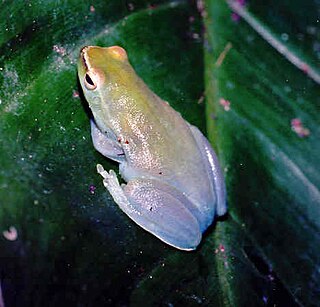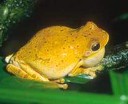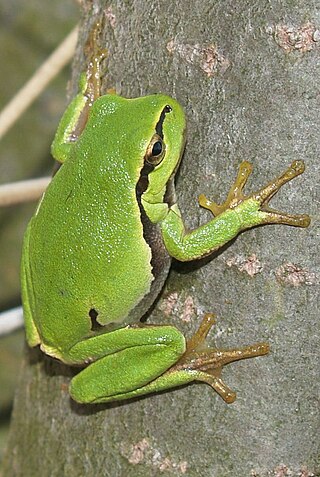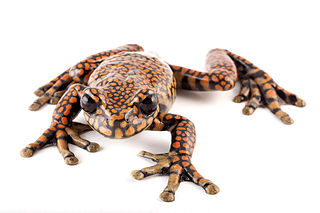
The Mexican burrowing tree frog (Smilisca), also known as the cross-banded tree frog, is a genus of frogs in the family Hylidae found in Mexico, southern Texas and Arizona, Central America, and northwestern South America. In a recent revision of the Hylidae, the two species of the previous genus Pternohyla were included in this genus. Its name is from the Ancient Greek smiliskos, referring to the pointed frontoparietal processes.

Sphaenorhynchus is a genus of frogs in the family Hylidae. They are also known as lime treefrogs or hatchet-faced treefrogs. They are found in the Amazon and Orinoco River basins of South America, the Guianas, Trinidad, and southern and eastern Brazil. The majority of the species are associated with the Atlantic Forest domain in Brazil.

Trachycephalus is a genus of frogs, commonly known as the casque-headed tree frogs, in the family Hylidae. They are found in Mexico, Central America, and South America. In a recent revision, the seven species of the genus Phrynohyas were included in this genus, and Phrynohyas is now considered a synonym of Trachycephalus. These frogs inhabit the canopies of tropical rainforests, where they breed in tree cavities, and seldom, if ever, descend to the ground.
Myersiohyla is a genus of frogs in the family Hylidae. It was erected in 2005 following a major revision of the Hylidae and initially included four species that were previously placed in the genus Hyla. The genus is found in the tepui region of Guyana and Venezuela.

Charadrahyla is a genus of frogs in the family Hylidae. It is endemic to tropical southern Mexico. The generic name was derived from Greek charadra ("ravine") and Hyla, in reference to the habits of these frogs. Accordingly, common name ravine treefrogs has been coined for the genus.
Megastomatohyla is a genus of frogs in the family Hylidae. They are endemic to the cloud forests of central Veracruz and Oaxaca, Mexico. All are rare species with restricted distributions. The generic name is derived from Greek mega (="large") and stem of the genitive stomatos (="mouth"), referring to the enlarged oral disc of the tadpoles, juxtaposed with Hyla, the genus in which the four Megastomatohyla species were previously placed. Common name large-mouthed treefrogs has been coined for this genus.

Tlalocohyla is a genus of frogs in the family Hylidae, also known as rain treefrogs or Middle American yellow-bellied treefrogs. They occur in Middle America between Mexico and Costa Rica. This genus was created in 2005 following a major revision of the Hylidae. The five species in this genus were previously placed in the genus Hyla.

Cruziohyla is a genus of frogs in the subfamily Phyllomedusinae. They occur from Honduras in Central America south to the Amazon Basin in South America. This genus was erected in 2005 following a major revision of the Hylidae and fully reviewed in 2018. Species in this genus were previously placed in the genera Agalychnis or Phyllomedusa.

Ecnomiohyla, commonly known as fringe-limbed treefrogs or marvelous frogs, is a genus of frogs in the family Hylidae. This genus was erected in 2005 following a major revision of Hylidae. The ten original species in this genus were previously placed in the genus Hyla. The generic name Ecnomiohyla comes from Greek ecnomios and Hylas, the companion of Hercules.

Bokermannohyla is a genus of frogs in the family Hylidae. It was erected in 2005 following a major revision of the Hylidae. Twenty-three species previously placed in the genus Hyla were moved to this genus named in honor of Werner Carlos Augusto Bokermann, Brazilian herpetologist. The genus is endemic to southern Brazil.
Bromeliohyla, sometimes known as the bromeliad treefrogs, is a genus of frogs in the family Hylidae. This genus was erected in 2022 following a major revision of the Hylidae. The original two species in this genus were previously placed in the genus Hyla. They are found in tropical southern Mexico, Belize, Guatemala, and northern Honduras.

Dendropsophus is a genus of frogs in the family Hylidae. They are distributed in Central and South America, from southern Mexico to northern Argentina and Uruguay. They are sometimes known under the common name Fitzinger neotropical treefrogs or yellow treefrogs

Hyloscirtus is a genus of Neotropical frogs in the family Hylidae. This genus was resurrected in 2005 following a major revision of the Hylidae, with the distinguishing features being 56 transformations in nuclear and mitochondrial proteins and ribosomal genes. Of these species, 28 species, previously placed in the genus Hyla, were moved to this genus. The fingers and toes of these frogs have wide dermal fringes.
Calamita melanorabdotus is a possible species of frog reported from Brazil in 1799. A 19th century treatise considered it to be a junior synonym of Hyla lactea, but it is now considered a nomen dubium.
"Calamita" quadrilineatus is a possible species of frog described in 1799. The type locality is unknown, but the original publication considered Calamita quadrilineatus to be similar to Hyla leucophyllata. The status of this name placed in the subfamily Hylinae is unclear and it is considered a nomen dubium. The type series is presumed to be lost.
Dendropsophus meridianus is a species of frog in the family Hylidae. It is endemic to southeastern Brazil.
Hyla auraria is a scientific name used by Wilhelm Peters to describe a species of frog in 1873 based on material that presumably originated from South America. The status of this name placed in the subfamily Hylinae is unclear. The holotype still exists and is in good condition but faded, and it has not been possible to relate it to known species or genera of frogs. Consequently, Hyla auraria is considered a nomen dubium.
The cloud forest tree frog is a species of frog in the family Hylidae endemic to Mexico. Its natural habitats are subtropical or tropical moist montane forests and rivers. It is threatened by habitat loss.

Hylinae is a large subfamily of "tree frogs", family Hylidae.

Cophomantini is a tribe of frogs in the subfamily Hylinae of the family Hylidae, the true treefrogs.












